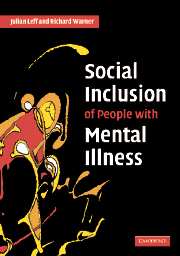Book contents
- Frontmatter
- Contents
- Preface
- 1 Introduction: barriers to social and occupational integration
- Part I The origins of stigma
- 2 The course of psychoses
- 3 The nature of stigma
- 4 Poverty and social disadvantage
- 5 Ameliorating users' symptoms
- 6 Dismantling psychiatric institutions
- 7 Reducing fear and discrimination among the public
- 8 Tackling self-stigmatisation
- Part II Overcoming obstacles to employment
- References
- Index
7 - Reducing fear and discrimination among the public
from Part I - The origins of stigma
Published online by Cambridge University Press: 24 October 2009
- Frontmatter
- Contents
- Preface
- 1 Introduction: barriers to social and occupational integration
- Part I The origins of stigma
- 2 The course of psychoses
- 3 The nature of stigma
- 4 Poverty and social disadvantage
- 5 Ameliorating users' symptoms
- 6 Dismantling psychiatric institutions
- 7 Reducing fear and discrimination among the public
- 8 Tackling self-stigmatisation
- Part II Overcoming obstacles to employment
- References
- Index
Summary
Using the mass media to influence public attitudes
We have discussed the bias of the media in selectively reporting violent incidents involving mentally ill people and in referring to such people in pejorative terms. This has an effect on the attitudes of the public towards psychiatric illnesses and service users. Given the ability of the mass media to reach entire populations of all ages, it is compelling to attempt to use them to instil positive attitudes about psychiatric illness. An early campaign in Canada by Cumming and Cumming (1957) targeting a local community was a dismal failure, the educators being rejected by the population. A similar attempt to change public attitudes in Northamptonshire, UK, was also ineffective (Gatherer and Reid, 1963). A national campaign was mounted by the UK Royal College of Psychiatrists, focusing on depression. Although a few significant positive changes occurred, they were disappointing given the effort invested in the campaign (Paykel et al., 1998). A subsequent attempt by the Royal College of Psychiatrists to reduce the stigma of a wide range of psychiatric disorders included a four-minute film that was screened before the main feature film in cinemas throughout the country. Once again, the impact on public attitudes was minimal.
The World Psychiatric Association (WPA) initiated a worldwide programme against the stigma of schizophrenia in 1996, which eventually involved 20 countries (Sartorius, 1997). The pilot site was in Calgary, a town in the Canadian province of Alberta.
- Type
- Chapter
- Information
- Social Inclusion of People with Mental Illness , pp. 76 - 86Publisher: Cambridge University PressPrint publication year: 2006

